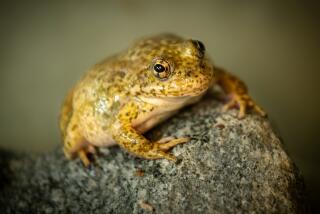Endangered mountain yellow-legged frogs might get a hoppy ending
To reach one of the last wild populations of the mountain yellow-legged frog on Earth, Adam Backlin and Elizabeth Gallegos tramped down a no-nonsense trail, scaled cliffs and barged through nettles along a vein of water in a scowling canyon deep in the San Gabriel Mountains.
Finally, the U.S. Geological Survey field biologists reached the headwaters of the Mojave River, about 15 miles west of Wrightwood. They forded pools and crawled through underbrush to net as many of the endangered frogs as possible and methodically record their vital statistics.
Recent efforts to save the frogs have included restricting public access and ridding the water of predatory trout. Now, the fist-sized amphibians are breeding in numbers not seen in decades.
PHOTOS: Endangered mountain yellow-legged frog
When Backlin and Gallegos visited recently, several hundred adult frogs shared the knee-deep pools with hundreds of wiggling tadpoles and dime-sized babies.
“Whoa!” Backlin shouted, diving head first into a tangle of branches shading a small patch of water boiling with frogs. With one sweep of the net, he pulled out half a dozen. In less than three hours, the biologists captured 71 adults of the species scientists know as Rana muscosa. Fifty-two had been tagged during previous forays into the canyon. But 19 were new frogs.
Two years ago, this 1.5-mile stretch of spring water and ice melt was thought to hold about five.
With skin as permeable as a mop, the species is susceptible to a skin fungus linked to amphibians vanishing around the world. And the fungus and its waterborne zoospores have been detected in mountain yellow-legged frogs.
Batrachochytrium dendrobatidis is a chytrid fungus first identified in 1998. It causes a thickening of the skin, which impairs gas exchange and the animal’s ability to absorb water, triggering rapid, mass die-offs.
“Exactly how they these frogs are surviving the fungus is a mystery,” Backlin said. “One theory is that after the fungus first swept through the San Gabriels in the 1960s — wiping out up to 90% of the entire frog population — survivors somehow developed an immunity.” Biologists will study possible defense mechanisms as they search for a cure to the fungus.
The life and times of mountain yellow-legged frogs embody the challenges facing species — and wildlife biologists — in Southern California. For thousands of years, the frogs thrived in almost all of the creeks cascading down the San Bernardino, San Gabriel and San Jacinto mountains.
Since the 1960s, however, the species has been decimated by fires, mudslides, pesticides, fungal infections and loss of habitat, as well as the appetites of garter snakes, raccoons and nonnative fish, bullfrogs and crayfish.
Recent efforts by zoos in Los Angeles, San Diego and Fresno to reintroduce captive-bred frogs into their ancestral haunts have had limited success.
PHOTOS: Endangered mountain yellow-legged frog
For the time being, the creation of trout-free zones in hard-to-reach streams is one of the most effective survival strategies. For example, in a remote corner of the San Jacinto Mountains, the frogs are starting to recolonize sections of Fuller Mill Creek where fish were removed by the California Department of Fish and Game and the U.S. Forest Service.
Usually found on sunny banks and rocks near riffles, the 3-inch-long frogs are named for the bright yellow extending from the undersides of the hind legs onto the lower abdomen.
“Amphibians in general, and frogs in particular, are resilient — if you give them a chance, they rebound,” said Sam Sweet, professor of ecology and evolution at UC Santa Barbara. “One reason they produce huge numbers of eggs is that life is so uncertain for an egg or tadpole. All those eggs compensate for years when creeks dry up, or predators and disease move in and wipe them all out.”
More to Read
Sign up for Essential California
The most important California stories and recommendations in your inbox every morning.
You may occasionally receive promotional content from the Los Angeles Times.











